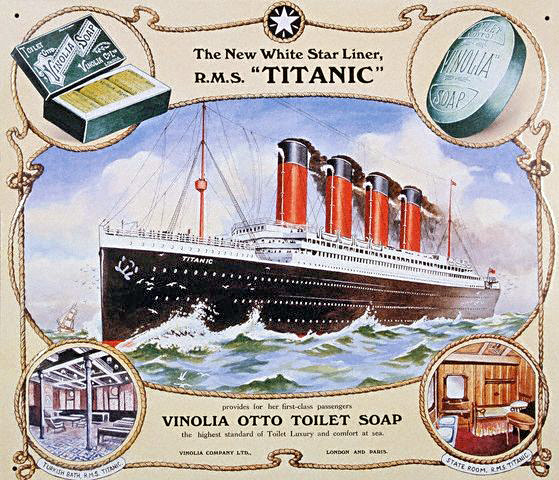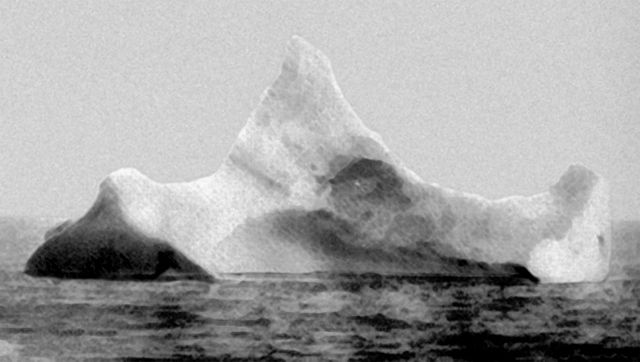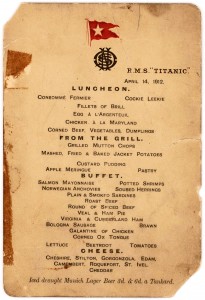
Photo: AP
Sunday, 14 April 1912 was what many survivors’ thought was the best day of the journey so far. Religious service was held in the First-Class dining room at 10:30 am. Many in first and second class had a very nice meal afterwards, followed by a stroll around the deck. Ice warnings had been received from other ships in the past two days, but no one had plotted them or gave them deep thought. Icebergs were common and no one thought they were that serious of an issue at the time. At noon the ship’s officers got together on the wing bridge to calculate the Titanic’s position.
About 1:42 pm, White Star Liner Baltic reported large quantities of field ice along with the coordinates. The message was delivered to Captain Edward J. Smith who passed it on to Joseph Bruce Ismay, chairman of White Star Line. The Amerika sighted a large iceberg at 1:45 pm and transmitted notice and its coordinates as well. As the afternoon progressed, air temperature began to drop and by 7:30 pm was at 33F. At 5:50 pm, Captain Smith orders the course to south and west of the usual course taken, possibly, due to the ice warnings.
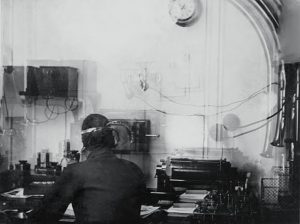
Public Domain/Wikimedia Commons
At 7:30 pm, the Californian reported three large icebergs, which were reported to the bridge while Second Officer Charles Lightoller is on duty. Captain Smith was attending a dinner in the First-Class Dining Room. Contrary to what is shown in A Night to Remember, messages were not delivered by the wireless operators but by the Titanic crew. Lightoller would order the crew to watch the fresh water supply as the temperature was dropping to freezing. Smith would return to the bridge at 8:55 pm and discuss with Lightoller the weather and icebergs. Captain Smith would retire for the night at 9:20 pm telling Lightoller to wake him “if becomes at all doubtful’. At 9:30 pm, Lightoller would advise the lookouts to watch for icebergs.
The Mesaba sent a warning of heavy pack ice and icebergs at 9:40 pm. However, due to heavy wireless passenger traffic, Jack Phillips was too busy to have it sent to the bridge. At 10:00 pm, First Officer William Murdoch would relieve Second Officer Lightoller. Lightoller would tell Murdoch of current conditions. The lookouts were also relieved by the new watch. Lookouts Frederick Fleet and Reginald Lee are advised to watch for icebergs. Since it is a moonless night and the sea calm, they will need to be extra alert in looking for any ice fields or icebergs that might appear. Also, they have no binoculars as they have been misplaced. The temperature continues to drop and is recorded at 31F.
The Californian decides to stop at 10:55 pm due to large field ice in its way. Warnings were sent out to all shipping in the area. The wireless operator contacts Titanic with additional ice warning. Jack Phillips sends back a blunt response telling him to shut up as he was sending messages through Cape Race. At around 11:00 pm, most people are either in bed or heading back to their cabins. A few might still be enjoying a drink, a card game, or reading. By 11:30 pm, the Californian wireless operator, after listening to Titanic’s message traffic, shuts down and goes to bed.
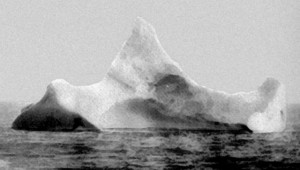
Just before 11:40 pm, lookouts spot an iceberg 500 feet away. Lookout Frederick Fleet rings the bell three times and calls the bridge telling Murdoch ‘Iceberg, right ahead.’ Titanic was doing around 21 knots (or slightly less) at the time. Murdoch gives the order “hard a starboard,” orders the engines stopped then full astern, and seals the watertight doors. Due to the size, ships of this size have a larger turning radius then most. At first it looked like Titanic would hit the iceberg dead on but then slowly veered to port to pass by on the starboard. Some speculate the iceberg may have been inverted making it larger underwater than on top. The iceberg makes contact with the ship causing large and small punctures in the process as it scraped the ship.
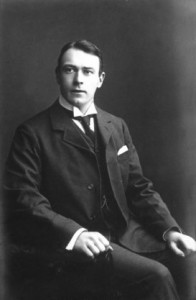
Public Domain/Wikimedia Commons
Captain Smith would come to the bridge to determine what happened and was informed they struck an iceberg. Reports started coming in of water in the mail room and other areas of the ship. Titanic designer Thomas Andrews assesses the damage along with Captain Smith. With water coming in the mail room and in the first five compartments of the ship, Andrews informs Smith that Titanic will stay afloat for 1 ½ to 2 hours. The ship could survive one compartment being damaged but all not all five with water coming pulling it down at the bow. Captain Smith was in a state of shock at this news and had to be prodded to order lifeboats be lowered, muster the crew, and evacuate the passengers. Since lifeboats were based on tonnage (per British Board of Trade regulations) and not capacity, 1,178 of 2,227 passengers could be put into them if filled to capacity.
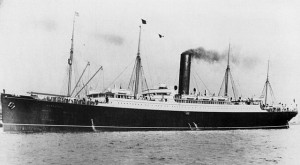
Image: public domain
At 12:15 am, Captain Smith orders wireless operators Jack Phillips and Harold Bride to send out distress messages. While SOS is the new distress signal, they also send out the older one CQD (come quick distress). Many ships will hear the distress but many like the Frankfurt are too far away to respond. On Carpathia, approximately 58 miles away, its wireless operator heard the message at 12.20 am, “Come at once. We have struck a berg. It’s a CQD, old man.” Once informed of this, Captain Arthur Rostron immediately orders his ship make to the coordinates provided by Titanic. As the ship speeds to the scene at top speed, he issues a flurry of orders to make ready the ship for receiving survivors. It would take three hours for Carpathia to arrive.
Since Titanic lacked a central alarm system to notify passengers to evacuate the ship, it fell to stewards and others to knock on passenger’s doors to rouse them. At first many did not believe the ship was in any danger but that would become apparent as time went on. Since the crew had not had any training or drills in lowering the lifeboats, they were unsure if the davits were strong enough or the capacity of the lifeboats. And the system of who could board lifeboats varied from port or starboard side. Lightoller was strict about women and children first. At 12:45 am, lifeboat number 7 on the starboard side was lowered but only had 27 people instead of full capacity of 65.
Titanic fired distress rockets as well to get the attention of any nearby ships. They were seen by the Californian, but they did not know the source and did not investigate. A ship appeared to be ten miles away but did not respond to rockets or the Morse lamp. Later some thought this was a Norwegian fishing vessel illegally hunting seals, but evidence did not confirm it. Whether this ship was a mirage caused by conditions on the sea or atmospherics, or the real thing, has never been confirmed. By 12:55 am, lifeboats 5 and 6 are lowered. Number 6 had passenger Molly Brown and lookout Frederick Fleet. Quartermaster Robert Hitchens, who was at the helm when Titanic struck the iceberg, would be criticized later for refusing to look for survivors.
By 1:00 am, lifeboat 3 is lowered and only carries 39 people, 12 from the crew. Lifeboat 1 is lowered with only 12 people. It is one of the emergency cutters designed for quick lowering and raising in cases of a person overboard. It can hold up to 40. Both Sir Cosmo Edmund-Duff Gordon and his wife, Lucy Duff-Gordon, are aboard this lifeboat. They would be accused, but denied it, of bribing the crew by giving them £5 each to keep others from using the boat. Sir Cosmo would say the money was offered to them for them to replace lost clothing and gear.
At 1:10 am, the first lifeboat on the port side is lowered. Number 8 only had 28 people on it and included the Countess of Rothes, Lucy Noel Martha. Ida and Isidor Strauss were offered seats on this lifeboat but declined. Isidor believed women and children should go first and Ida did not want to leave her husband. “Where you go, I go,” she said. Both would remain aboard Titanic and perish when it sank. Lifeboat 10 is launched at 1:20 am and had the nine-week-old Milvina Dean on it. She would become later one of the survivors often interviewed about Titanic and lived a long life till dying in 2009 at the age of 97. Lifeboat 9 is launched and is near capacity at 56 people aboard. Benjamin Guggenheim’s mistress was aboard, but he remained with his valet aboard the ship dressed in formal attire.
On Olympic, there was some confusion about the distress call they received. It is possible that with all the signals going out that night, that some got jumbled up (this proved true later when apparently confusing messages were received in New York). About 1:25 am, they radioed Titanic asking if they were steaming to meet them. The response was simple: that they were putting women off in the boats. Later Olympic would be informed by Carpathia of the sinking. Panic was starting to set in aboard the ship as it became very obvious by this time she was sinking and filling up with water. A panic near lifeboat 14 caused Fifth Officer Boxhall to discharge his weapon. He took command of the lifeboat and would later transfer people into other lifeboats so they could look for survivors. The lowering of lifeboat 13 is quickly followed by 15. However, it drifts underneath the lowering lifeboat but quick action by crewman in 13 saves it by cutting the ropes and rowing away.
Between 1:35-1:40 am lifeboat 16 and collapsible C is lowered. On C is White Star chairman J. Bruce Ismay. Later he would be criticized for boarding before women and children. He would claim that neither were around when he boarded the lifeboat. True or not, it would stick with him for the rest of his life with some calling him a coward. By 1:45 am, Emergency Cutter 2 is launched with Boxhall with 20 people. Lifeboats 11 and 4 would be launched as well. Madeline Astor, five months pregnant, is aboard number 4. Her husband, John Jacob Astor, would ask to join her but Lightoller, who followed the order of women and children first, declined. Astor’s body would later be recovered.
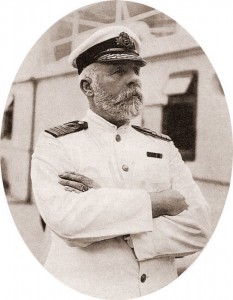
Author unknown. Published after sinking in 1912
Public Domain/Wikipedia Commons
By 2 am only the collapsible boats remain. Titanic had sunk low enough that the stern propellers were now visible. Collapsible lifeboat D is launched from the roof of the officer’s quarters and would have 20 people in it. Collapsible A is washed off the deck and partly filled with water. Fifth Officer Harold Lowe in lifeboat 14 finds only 12 of the 20 that got into it are alive. Collapsible B falls and is swept off before it can be righted. The now overturned lifeboats are used by 30 people including Lightoller and wireless operator Bride. At this point, Captain Smith releases the crew saying, “it’s every man for himself.” Smith was last seen on the bridge and his body was never recovered. Wireless operator Phillips sends the final distress signal at 2:17 am. He made it to collapsible lifeboat B but died from exposure. His body would not be recovered.
Titanic is plunged into darkness as its power generators fail. The bow continues its inexorable pull downward as the stern rises higher out of the water. Around 2:18 am, the tremendous strain on the midsection of the ship causes it to break in two between the third and fourth funnels. The bow would disappear beneath the waves while the stern settled back in the water. At this moment, those on the stern can literally swim away before it starts rising. Water would fill into the stern causing it to rise and becoming vertical. At 2:20 am, it would begin the final plunge and disappear. The Titanic was gone.
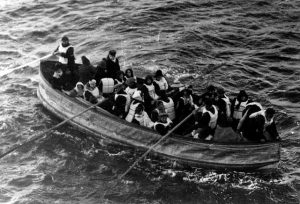
Public Domain(Wikipedia)
Carpathia would arrive in the area firing rockets to get attention at around 3:30 am. Lifeboat 2 was the first to reach the rescue ship. It would take several hours to pick up all the survivors. Ismay would send a message to the White Star Line office informing Titanic sank. He then would isolate himself in a cabin for the remainder of the voyage to New York. The Californian arrived on scene at 8:30 am. They learned of the sinking around 5:30 am. They find no survivors.
At 8:50 am, Carpathia sounded her whistle and began heading to New York with the 705 survivors aboard. Due to garbled and mixed-up messages, the American press believed at first disaster had been averted and she was in tow. People were gathering outside of the White Star Liner offices in New York, London, and other offices for information. The White Star Line office in New York believed Titanic was okay and conveyed that to the public that morning. However, that changed by the afternoon when Ismay’s message from Californian was received, and other information also confirmed it as well. Titanic, the pride of the White Star Line, had sunk on her maiden voyage taking 1,500 lives with only 705 survivors.
Sources:
Books
Behe, George TITANIC: SAFETY, SPEED AND SACRIFICE, Transportation Trails, Polo, IL 1997
Eaton John P. & Haas Charles, TITANIC TRIUMPH AND TRAGEDY, SECOND EDITION, W.W. Norton & Company, New York, New York, 1995 First American Edition
Lord, Walter, A NIGHT TO REMEMBER, Holt Rinehart and Winston, New York, New York, 1955. Multiple revisions and reprints, notably Illustrated editions (1976,1977,1978 etc)

